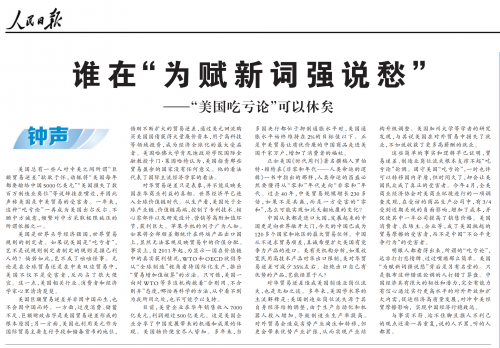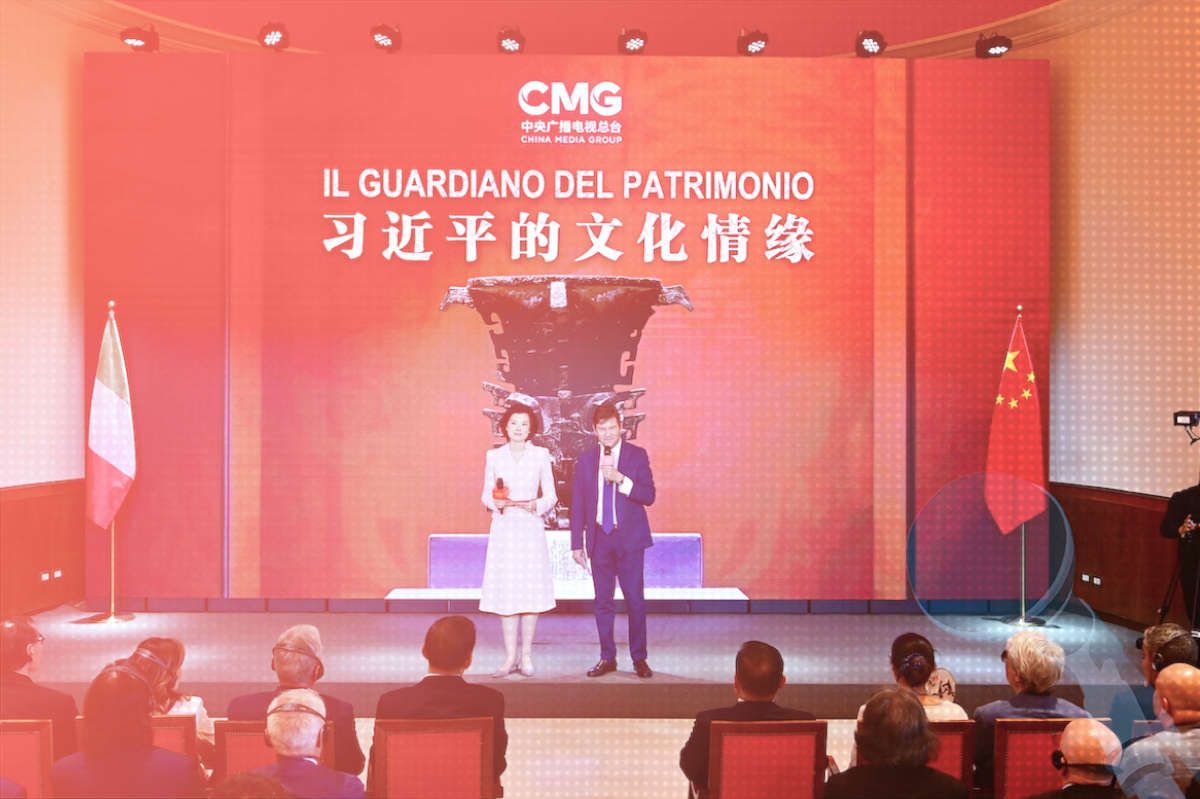Headlines and Hashtags
Trump and Xi: Are Things Getting Personal?
Responding to the escalating trade war between the U.S. and China, Stephen Collinson wrote at CNN today that this is getting personal, and is shaping up as “a personal duel between two rival presidents.” Today, however, it seemed that the People’s Daily, generally the best visible measure we have of the mood within the Chinese Communist Party, did its utmost to avoid personal attack.
In typical form, a front-page piece (with jump to page 3) attributed to “Zhong Sheng” (钟声), a byline for official commentaries on international affairs, does not mention Trump by name at all. Trump, rather, is invoked indirectly in the first line of the piece, which growls about “certain people in America who brood over the so-called ‘massive trade deficit’ between the U.S. and China, with things like, ‘The U.S. loses 500 billion dollars a year to China.'”
We all know that means Trump. So why not just say it?
I’ll come back to this commentary in a moment. But I want to note first that media reports outside China may be playing just a bit too freely with the language emerging from state media, noting a hint of truculence that is more precisely an attempt, out of some degree of unease, to shore up domestic confidence in light of recent events. It has been widely reported, for example, that the Global Times remarked in reference to the new round of tariffs that “this is a true ‘people’s war.” And the Financial Times has reported that China’s state media have responded to the tariffs with “a barrage of nationalist commentary.” OK, perhaps a touch more stridence. But weren’t we reporting the same thing back in July, and August, and September too?

Yes, it’s certainly true that the language of “people’s war” hearkens back to Mao Zedong. It was famously used by Lin Biao in 1965 in an article called “Long Live the Victory in the People’s War” (人民战争胜利万岁) that commemorated the 20th anniversary of victory in the war against Japan. But the basic sense of the “people’s war” is that the people need to unite behind the leadership of the CCP to engage in struggle. The term has been used in recent decades to refer in a rather general way to challenges that require the full participation of society. For example, of the 16 articles in the Party’s official People’s Daily that use the term “people’s war” in the headline since 2009, going back 10 years, 11 deal with the combatting drug use in society.
In this sense, talk of a “people’s war” is of a piece with statements we’ve heard on CCTV and from the foreign ministry about China’s readiness to stand up. It is less a war cry than an implied statement to the public: Look, things are going to get tough, and you need to stand behind us.
The “Zhong Sheng” commentary in today’s People’s Daily is perhaps a better measure of China’s tone, and in it we hear the leadership treading a very careful line — trying to land punches and pull them at the same time. There is a need to signal resolve, displeasure, even anger of the righteous kind. But at the same time, it avoids directly antagonizing anyone.
Rhetorically, the piece does criticize the U.S., which it suggests has always behaved with global selfishness, viewing rules and norms only as tools to be cynically used. “Regrettably, the U.S. has always maintained an attitude toward the WTO and other multilateral institutions of ‘using them when it suits, and abandoning them when it does not’ (合则用、不合则弃),” the commentary reads. “Even where well-considered methods are concerned, it will not support them if it cannot first see the advantage to itself.” But the commentary quickly moves away from criticism of this broader U.S., the U.S. of “certain people,” to get more personal about the “American consumers, farmers and enterprises,” which have “become the victims of the trade tensions stirred up by the U.S., not victims of ‘unfair Chinese trade practices.'”
Another interesting and quite typical characteristic of this official commentary is the way it rallies American voices to its causes, with oblique references to various experts and authors, as though only quoting a Harvard professor (in this case, Carmen Reinhart, whose gender the paper gets wrong) can make an argument against U.S. actions convincing. The byline “Zhong Sheng” is a homonym of “China’s voice,” so it is interesting to consider the implications of this habitual, institutionalized deployment of foreign voices in China’s state media as a means of shoring up credibility.
In this vein, it is even more interesting to note the way the commentary talks about the need to move away from zero-sum thinking. It makes no reference at all to Xi Jinping’s catchphrase about building “a community of common destiny for humankind,” or renlei mingyun gongtongti (人类命运共同体), which is all wrapped up in this notion of win-win and a key part of China’s current foreign policy, even written into the Constitution in 2017. Instead, it cites journalist Robert Wright’s 1999 book Nonzero: The Logic of Human Destiny. It is as though Xi’s catchphrase is peeking out from behind the cover of an American author. Again, it seems the impetus is to downplay China’s assertiveness even as it tries to make its stand. State media have made a great deal of this catchphrase around the policy of the Belt and Road, but perhaps now is not the time to advertise the supposed uniqueness and world-transforming character of (imagined) Chinese alternatives.
So far, this “duel” between Trump and Xi is not visible in China’s official state media. This is a dicey time, and a dicey year, full of dicey anniversaries. The last thing China’s leaders want is for things to get personal. But we’ll keep watching the media space.
Meanwhile, a quick translation of the “Zhong Sheng” commentary in the People’s Daily. For questions of accuracy and phrasing, please refer back to the original, linked below.
_________________
Who’s Worked Up About Neologisms: Enough With America’s ‘Doctrine of Loss’
Zhong Sheng (钟声)
People’s Daily
May 14, 2019
There are always certain people in America who brood over the so-called “massive trade deficit” between the U.S. and China, with things like, “The U.S. loses 500 billion dollars a year to China,” or, “The U.S. loses millions of manufacturing jobs to China,” hanging on their lips at every turn. Over the past year, this sort of “doctrine of loss” (吃亏论) has become the imagined evidence used again and again, hot and cold, to exercise extreme pressure on the Chinese side, flying in the face of Chinese sincerity.
The U.S. is the strongest economy in the world, and the maker of rules when it comes to the world economy. If we are to accept that the U.S. is the “loser” (吃亏者), isn’t this essentially saying that the rules made by the rule-maker have been harmful to itself? If this is the case, is it not the strangest thing. [But] if whether we talk about global trade or about the U.S.-China bilateral trade, not only is the U.S. not the loser — quite the opposite, it takes a lot of advantages. This is something about which American industries, consumers and economists are very clear in their hearts.
America’s massive trade deficit has not emerged because of China, and it will not come to an end because of China. On the one hand, excessing spending, insufficient savings and a huge fiscal deficit are the principal reasons for the deficit; on the other hand, the United States uses the US dollar as the main means of payment for international trade with the status of a reserve currency, expanding the trade deficit, and then it uses the dollar to purchase U.S. Treasury Bonds, obtaining massive amounts of cheap capital that it then invests in high-tech and other fields, making itself the biggest beneficiary of economic globalization. Carmen Reinhart, a professor of international finance at Harvard’s Kennedy School, believes that there is no sense at all in the U.S. pointing fingers at countries with which it has a trade deficit. His views represent the views of mainstream international economists [NOTE: The article uses the male pronoun here, though Reinhart is a woman].
The trade deficit with China is just an idea, and it cannot reflect the truth about America’s commercial interests in China. The world economy long ago entered the era of global value chains. Looking at production, [we see that] the U.S. is at the high end (高端)of the global value and global pricing chains, controlling patented technologies, core components, research and development and design, sales and other added-value segments, reaping huge benefits. The example of the iPhone is familiar to all. If we calculate surpluses only with the figures of those countries exporting end products, it is obviously impossible to reach an objective evaluation of value distribution in trade. In fact, from 2011, in order to [better] reflect a country’s true benefit within the value chain, the WTO and the OECD advocated the use of “global manufacturing” to approach international production, and introduced the method of “trade in value added” (贸易增加值核算). But regrettably, the U.S. has always maintained an attitude toward the WTO and other multilateral institutions of “using them when it suits, and abandoning them when it does not” (合则用、不合则弃). Even where well-considered methods are concerned, it will not support them if it cannot first see the advantage to itself.
Right now, U.S.-funded enterprises sell 700 billion dollars in China every year, earning profits of around 500 billion dollars. This is a benefit and opportunity reaped for U.S. companies as a result of China’s development. Low commodity prices in the U.S. are something known to all. For many years, as the central banks of many other countries have been busy trying to control inflation levels, inflation the U.S. has pushed below the target level of 2 percent. High quality and low-price Chinese products have flowed to the families of America, a great boon for consumers. As Time magazine journalist Robert Wright wrote in his book Nonzero: History, Evolution and Human Cooperation, the fate of mankind depends on understanding that we have moved from an era of “zero-sum” to an era of “nonzero.” Over the past 40 years, the scale of U.S.-China trade has expanded more than 230 times — if this [trade] was not win-win, but a “zero-sum” situation in which one side was the loser, how could it have produced such dramatic change?
China has always been a major importing country, and developing China has opened its doors to the world. China has today become the largest trade partner for more than 120 countries and regions. China has never sought trade surpluses, and it earnestly hopes to expand the import of competitive American products. According to the analysis of relevant U.S. institutions, if export restrictions for high-technology goods for civilian use were relaxed, the U.S. trade deficit toward China would contract by around 35 percent. And who is to blame for restricting the export of its own superior products?
This talk of the trade deficit with China resulting in the loss of American manufacturing jobs is also nonsense. For many years, the mainstream explanation emerging from academia in the U.S. has been that the loss of manufacturing jobs in the U.S. is attributable to its own economic restructuring, and that automation and mechanization have caused rises in productivity in manufacturing. External trade results in the phasing out and transition of inferior industries, but also brings opportunities for the expansion of higher quality industries, achieving industrial restructuring. Research from scholars at the University of California has shown that saying the U.S. has lost jobs in the course of U.S.-China trade is less appropriate than saying that it has reaped greater benefits in terms of high-paying employment.
These simple facts and logic long ago proved that this talk of trade deficits and job losses in manufacturing cannot support this “doctrine of loss.” Insisting on this “doctrine of loss” may for a time provide a distraction from domestic contradictions, but before long the American people will become the true losers. In April this year, the National Association for Business Economics revealed in a survey of the economic environment that three-quarters of manufacturers responding said that the [U.S.] tariffs had had a negative impact on them, raising their costs and forcing half of these companies to raise their prices. American consumers, farmers and enterprises have become the victims of the trade tensions stirred up by the U.S., not victims of “unfair Chinese trade practices.”
Anyone who can see clearly will realize that this so-called “doctrine of loss” is about more than just putting on a sad face and seeking sympathy. There is more behind this inventing of despondent neologisms than meets the eye. It’s just that those encouraging this incorrect view [about the trade deficit] have miscalculated. China’s economy has great resilience and potential, and it fully has the capacity and confidence to encourage higher-level development through higher-level openness toward the outside and the expansion of domestic demand, promoting high-level economic development, hedging against the impact of trade frictions between China and the U.S., and achieving long-term stability for the Chinese economy.
The continued repetition of these patently false, untenable and detrimental views may not tire those who utter them, but they exhaust all who listen.






















